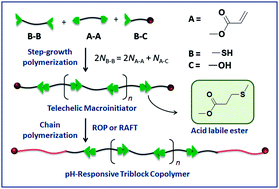Stimuli responsive triblock copolymers by chain-growth polymerization from telechelic macroinitiators prepared via a step-growth polymerization†
Abstract
Various chain-growth polymerizations have produced macromolecules of the desired molecular weight with a narrow weight distribution, allowing the incorporation of specific terminal groups and pendant functionalities and also enabling the synthesis of block copolymers. On the other hand, step-growth routes provide ample opportunities for functional diversity in the polymer backbone. Therefore, a strategy for the synthesis of block copolymers involving both of these synthesis routes in sequential fashion would be highly useful for making new polymers with structural diversity. This article describes such an approach for accessing stimuli responsive ABA type triblock copolymers. A telechelic polymer (TP) is prepared using a polycondensation between an A–A (A = acrylate) and a B–B (B = thiol) monomer in the presence of a monofunctional impurity B–C (C = hydroxyl) via a high yielding thiol–acrylate Michael addition reaction. Proper control of the stoichiometry of the three reactants ensures the presence of hydroxyl groups at both ends of the TP. Good corroboration between the theoretical and experimentally determined (using GPC and NMR) molecular weights suggests a lack of any undesirable side reactions during the polycondensation. The two terminal –OH units are utilized as initiating sites for the ring opening polymerization (ROP) of a cyclic lactide monomer in the presence of a tin catalyst to produce an ABA type triblock copolymer. As the repeating unit of the “B” block contains an acid labile β-thiopropionate linker, the resulting block copolymer can be degraded using a mild acid treatment. The free –OH groups at both terminals of the TP are then further linked to a chain transfer agent by an esterification reaction and the resulting macro-CTA is used to polymerize N-isopropylacrylamide via a RAFT polymerization, resulting in an amphiphilic triblock copolymer that exhibits a lower critical solution temperature (LCST). Detailed aggregation studies of the amphiphilic polymer by DLS, SLS, TEM and optical spectroscopy show the formation of polymersomes in the aqueous medium, which can encapsulate both hydrophobic and hydrophilic guest molecules.


 Please wait while we load your content...
Please wait while we load your content...